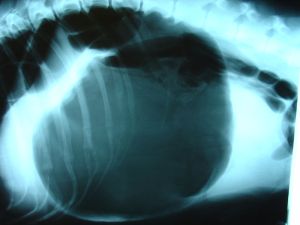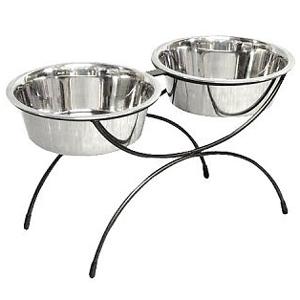Bloat in dogs, otherwise known as gastric dilatation-volvulus (GDV) is a very serious health risk and potentially life-threatening condition where the stomach becomes stretched by excessive gas content. As the stomach swells, twisting can occur between the esophagus and upper intestine, thereby preventing the animal from relieving the condition by belching or vomiting. The bloated stomach obstructs veins in the abdomen, leading to low blood pressure, shock, and damage to internal organs. The combined effect can quickly kill a dog.

Photo of an x-ray showing gastric dilatation and volvulus in a German Shepherd Dog. The large dark area is the gas trapped in the stomach.
Large breed dogs, especially those that are deep chested, are more susceptible to bloat. According to Wikipedia.org, the five breeds at greatest risk are Great Danes, Weimaraners, St. Bernards, Gordon Setters, and Irish Setters. In fact, the lifetime risk for a Great Dane to develop bloat has been estimated to be close to 37 percent. Standard Poodles are also at risk for this health problem, as are Doberman Pinschers and Rottweilers. Basset Hounds have the greatest risk for dogs less than 23 kg/50 lbs.
Some of the more common causes of bloat are rapid eating, eating dry foods that contain fat among the first four ingredients, foods such as kibble that expand in the stomach, drinking too much water before and after eating, drinking too much water too quickly, excessive exercise immediately after eating/drinking, stress and heredity.
Prevention of bloat can be difficult, especially for the dog who has had a relative experience bloat, and avoiding the causes listed above can certainly help. However, there is a misconception out there that elevated dog dishes will help prevent bloat. The thought being an elevated feeder will align the head allowing for a balanced eating position and better digestion. Actually, studies are now showing that the opposite may be true…that elevated feeders may actually be a cause of bloat.
An elevated feeder can cause a dog to inhale more air and allow the dog to eat its food at a faster than normal rate. Both of which are causes of bloat.
The Glickman et al study, done on large and giant breed dogs, found that use of a raised feeder actually increases the risk of bloat by 110%. Dr. Glickman’s data showed that “approximately 20% and 50% of cases of GDV among the large and giant breed dogs, respectively, were attributed to having a raised food bowl.” (J Am Vet Med Assoc 2000;217:1492-1499).
While there are many benefits to using an elevated dog dish to feed your dog, new studies are showing that the prevention of bloat may not be one of them and in fact, they could actually lead to bloat. Careful research should be done before an owner decides to purchase an elevated feeder for a dog that may be susceptible to bloat.
References:
Wikipedia: http://en.wikipedia.org/wiki/Bloat
Peteducation.com: Bloat (Gastric Dilatation and Volvulus) in Dogs
Vet Info: How an Elevated Dog Feeder Could Lead to Bloat
Globalspan.net: Bloat in Dogs




[…] The Myths of Elevated Dog Dishes and Bloat […]
A pet crate has to be less massive for smaller iggy, a 20 gallon tank is sufficient for your green
iguana of 10 inches. Succeeding feeding all through out the day can also
be done but only in small quantity. Impaction in iguanas occurs when the intestine becomes blocked with
indigestible material.
Diseases that cause hormonel imbalances and improper
habitat temperatures also increase the risk of MBD.
In the wild, the iguana must survive so they are usually very fast.
They’re also far too small even for a juvenile iguana.
Why visitors still make uuse of to redad news papers when in this technological
globe the whole thing is presented on web?
Hello to all, the contents present at this website are in fact awesome
for people experience, well, keep up the nice work fellows.
I do not know whether it’s just me or if everybody else experiencing issues
with your website. It appears as though some of
the written text on your content are running off the screen. Can someone else please comment and let me know if this is happening to them too?
This may be a problem with my web browser because I’ve
had this happen before. Appreciate it
After I originally commented I appear to
have clicked on the -Notify me when new comments are added- checkbox and now whenever
a comment is added I recieve four emails with the exact same comment.
Perhaps there is an easy method you can remove
me from that service? Kudos!
je viens de partager ! par contre, petite précision au sujet de 08, l’album NecroPedoSadoMaso vient de SEWER et non de Antekhrist… à méditer 😉
This web site certainly has all the information I needed
about this subject and didn’t know who to ask.
Regularly brushing your dog’s teeth, along with a healthy diet and plenty of chew toys, can go a long way toward keeping her mouth healthy. Bacteria and plaque-forming foods can cause build-up on a dog’s teeth. This can harden into tartar, potentially causing gingivitis, receding gums and tooth loss. Many pooches show signs of gum disease by the time they’re four years old because they aren’t provided with proper mouth care.